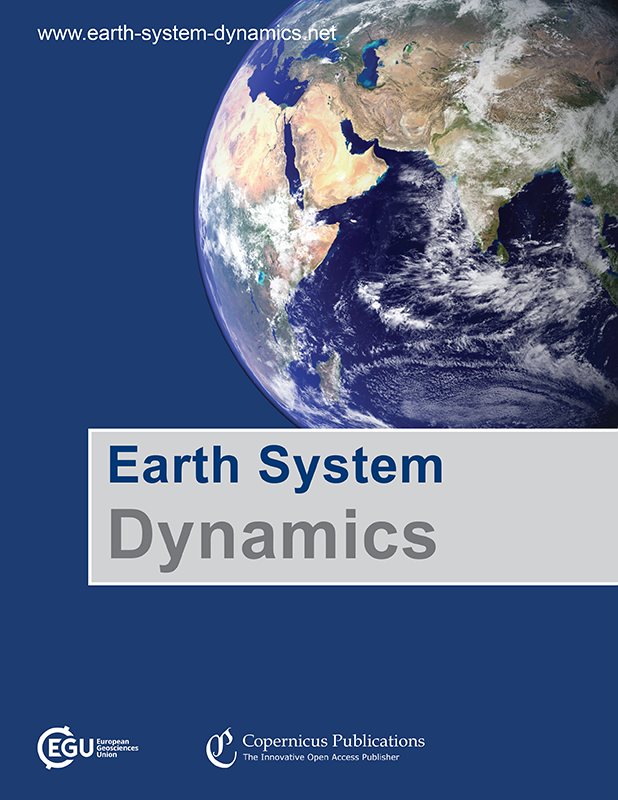Synchronization phenomena observed in glacial–interglacial cycles simulated in an Earth system model of intermediate complexity
IF 7.2
2区 地球科学
Q1 GEOSCIENCES, MULTIDISCIPLINARY
引用次数: 0
Abstract
Abstract. The glacial–interglacial cycles of the Quaternary exhibit 41 kyr periodicity before the Mid-Pleistocene Transition (MPT) around 1.2–0.8 Myr ago and ∼ 100 kyr periodicity after that. From the viewpoint of dynamical systems, proposed mechanisms generating these periodicities are broadly divided into two types: (i) nonlinear forced responses of a mono- or multi-stable climate system to the astronomical forcing or (ii) synchronization of internal self-sustained oscillations to the astronomical forcing. In this study, we investigate the dynamics of glacial cycles simulated by the Earth system model of intermediate complexity CLIMBER-2 with a fully interactive carbon cycle, which reproduces the MPT under gradual changes in volcanic-CO2 degassing and regolith cover. We report that, in this model, the dominant frequency of glacial cycles is set in line with the principle of synchronization. It is found that the model exhibits self-sustained oscillations in the absence of astronomical forcing. Before the MPT, glacial cycles synchronize to the 41 kyr obliquity cycles because the self-sustained oscillations have periodicity relatively close to 41 kyr. After the MPT the timescale of internal oscillations becomes too long to follow every 41 kyr obliquity cycle, and the oscillations synchronize to the 100 kyr eccentricity cycles that modulate the amplitude of climatic precession. The latter synchronization occurs with the help of the 41 kyr obliquity forcing, which enables some terminations and glaciations to occur robustly at their right timing. We term this phenomenon vibration-enhanced synchronization because of its similarity to the noise-enhanced synchronization known in nonlinear science. While we interpret the dominant periodicities of glacial cycles as the result of synchronization of internal self-sustained oscillations to the astronomical forcing, the Quaternary glacial cycles show facets of both synchronization and forced response.在中等复杂程度地球系统模型模拟的冰川-间冰期周期中观察到的同步现象
摘要第四纪的冰川-间冰期周期在距今约1.2-0.8百万年前的中更新世转变(MMT)之前表现出41 kyr的周期性,在此之后则表现出100 kyr的周期性。从动力系统的角度来看,产生这些周期性的机制大致分为两类:(1)单稳定或多稳定气候系统对天文作用力的非线性强迫响应;(2)内部自持振荡对天文作用力的同步响应。在这项研究中,我们研究了具有中等复杂性的 CLIMBER-2 地球系统模式所模拟的冰川周期动力学,该模式具有完全交互的碳循环,再现了火山-CO2 脱气和岩石覆盖渐变下的 MPT。我们报告说,在该模型中,冰川周期的主要频率是根据同步原则设定的。我们发现,在没有天文强迫的情况下,该模型表现出自我维持的振荡。在 MPT 之前,冰川周期与 41 kyr 的赤纬周期同步,因为自持振荡的周期性相对接近 41 kyr。在 MPT 之后,内部振荡的时间尺度变得太长,无法跟随每个 41 kyr 的赤纬周期,因此振荡会与 100 kyr 的偏心率周期同步,而偏心率周期会调节气候前倾的幅度。后一种同步现象是在 41 kyr 偏心强迫的帮助下发生的,这使得一些终止和冰川作用能够在正确的时间有力地发生。我们将这种现象称为振动增强同步,因为它与非线性科学中已知的噪声增强同步相似。虽然我们将冰川周期的主要周期性解释为内部自持振荡与天文强迫同步的结果,但第四纪冰川周期显示出同步和强迫响应的两面性。
本文章由计算机程序翻译,如有差异,请以英文原文为准。
求助全文
约1分钟内获得全文
求助全文
来源期刊

Earth System Dynamics
GEOSCIENCES, MULTIDISCIPLINARY-
CiteScore
13.20
自引率
5.50%
发文量
61
审稿时长
36 weeks
期刊介绍:
Earth System Dynamics (ESD) is a not-for-profit international scientific journal committed to publishing and facilitating public discussion on interdisciplinary studies focusing on the Earth system and global change. The journal explores the intricate interactions among Earth's component systems, including the atmosphere, cryosphere, hydrosphere, oceans, pedosphere, lithosphere, and the influence of life and human activity. ESD welcomes contributions that delve into these interactions, their conceptualization, modeling, quantification, predictions of global change impacts, and their implications for Earth's habitability, humanity, and the future dynamics in the Anthropocene.
 求助内容:
求助内容: 应助结果提醒方式:
应助结果提醒方式:


